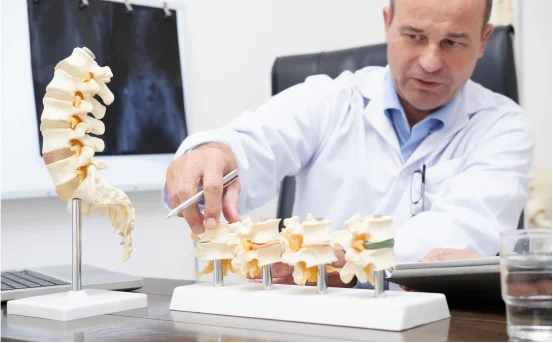Causes for kyphoplasty surgery is a minimally invasive procedure designed to treat spinal compression fractures, primarily caused by weakened vertebrae. Whether due to osteoporosis, trauma, or cancer, these fractures can lead to intense pain, reduced mobility, and even spinal deformity. Kyphoplasty not only relieves pain but also restores the height and stability of the affected vertebra.
One of the most effective treatments for such fractures is kyphoplasty, a minimally invasive spinal surgery that stabilizes the broken vertebra, alleviates pain, and restores lost vertebral height. Kyphoplasty is increasingly used around the world due to its high success rate, short recovery time, and long-lasting benefits for patients dealing with severe back pain caused by spinal fractures.
What Is Kyphoplasty Surgery?
Before diving into the causes, it’s important to understand what kyphoplasty involves. Kyphoplasty is a specialized spinal procedure where a balloon is inserted into a compressed vertebra to create space, which is then filled with bone cement. This helps :-
-
Stabilize the fracture
-
Restore vertebral height
-
Reduce or eliminate pain
-
Prevent further spinal deformity
The procedure is usually performed on an outpatient basis under local or general anesthesia and offers rapid pain relief in most cases.
Common Causes for Kyphoplasty Surgery
Let’s take a closer look at the main conditions that necessitate kyphoplasty surgery:
Osteoporosis-Induced Vertebral Compression Fractures (VCFs)
Osteoporosis is by far the most common cause for kyphoplasty. This bone-thinning disease weakens the vertebrae, making them prone to fractures from minimal stress or trauma.
Why it matters :-
-
Osteoporotic fractures can occur even from simple movements like bending or lifting light objects.
-
VCFs due to osteoporosis often lead to sudden, sharp back pain.
-
Left untreated, these fractures may cause kyphosis (curved spine), loss of height, and chronic pain.
Kyphoplasty is recommended when conservative treatments like pain medications, bracing, or physical therapy fail to relieve symptoms within a few weeks.
Traumatic Spinal Fractures
A traumatic injury, such as from a car accident, fall, or sports activity, can cause compression fractures in otherwise healthy spines.
Indicators :-
-
Sudden onset of severe back pain following trauma
-
Visible deformity or inability to stand upright
-
X-rays or MRIs revealing collapsed or compressed vertebrae
In such cases, kyphoplasty is considered when there’s :-
-
Loss of vertebral height
-
Pain not managed by medications
-
Structural instability in the spine
This helps patients recover faster and return to normal activities sooner.
Cancer-Related Vertebral Lesions
Cancer can weaken bones through metastasis (spread of cancer to the spine) or due to primary spinal tumors like multiple myeloma.
How cancer affects the spine :-
-
Tumors can erode vertebral bone, causing fractures and instability.
-
Pain from spinal metastases may become debilitating.
-
Patients may suffer from nerve compression, affecting mobility and organ function.
Kyphoplasty provides not only pain relief but also structural support, allowing patients to continue cancer treatments more comfortably.
Osteopenia and Age-Related Bone Loss
Even without full-blown osteoporosis, age-related bone density loss (osteopenia) can increase fracture risk. Older adults, especially postmenopausal women, are more prone to spontaneous vertebral fractures.
Why age matters :-
-
With age, spinal discs shrink, and vertebrae become brittle.
-
Repeated stress on the back (e.g., from lifting or poor posture) may cause microfractures.
-
Kyphoplasty can prevent these small injuries from worsening over time.
Early intervention with kyphoplasty may prevent spinal curvature and long-term disability.
Steroid-Induced Bone Weakening
Long-term use of corticosteroids (for asthma, autoimmune diseases, or organ transplants) can lead to bone thinning and fragility.
How steroids affect bones :-
-
They decrease calcium absorption and reduce bone formation.
-
Patients on chronic steroid therapy have a high risk of developing VCFs.
-
Sudden back pain in such patients may indicate a compression fracture.
Kyphoplasty helps such individuals regain function without having to stop necessary medications.
Vertebral Hemangiomas and Benign Tumors
While rare, benign vascular tumors like vertebral hemangiomas can weaken the structure of a vertebra.
Symptoms and risks :-
-
Often asymptomatic, but some hemangiomas can expand and compress the spinal cord or nerves.
-
These tumors may cause pain, neurological symptoms, or pathologic fractures.
Kyphoplasty may be performed to stabilize the vertebra and prevent further complications, especially when surgery for tumor removal isn’t feasible.
Multiple Compression Fractures
Sometimes, patients suffer from multiple vertebral fractures simultaneously, especially those with severe osteoporosis or metastatic cancer.
Challenges :-
-
These fractures can cause significant spinal deformity (dowager’s hump).
-
Breathing difficulty, reduced mobility, and chronic fatigue may follow.
-
Pain medications alone may not provide adequate relief.
In these cases, multi-level kyphoplasty may be done to stabilize several vertebrae, improving posture and restoring quality of life.
When to Consider Kyphoplasty
While not every compression fracture requires surgery, kyphoplasty is advised when :-
-
Pain persists despite 2–3 weeks of conservative treatment
-
Imaging confirms vertebral height loss or bone collapse
-
Patient experiences impaired mobility or nerve symptoms
-
There’s significant risk of spinal deformity progression
Benefits of Kyphoplasty
Kyphoplasty offers several advantages, especially when performed promptly :-
-
Rapid pain relief (often within 48 hours)
-
Improved spine alignment
-
Minimal recovery time
-
Outpatient procedure in most cases
-
Low risk of complications when performed by a skilled surgeon
Who Should Avoid Kyphoplasty?
Though highly effective, kyphoplasty isn’t suitable for everyone. It may not be recommended if :-
-
Fracture is older than 2–3 months and has already healed
-
Infection is present in the spine
-
There’s bleeding disorder or uncorrected coagulopathy
-
Pain isn’t clearly linked to a vertebral fracture
In such cases, alternate therapies like physical rehab, pain blocks, or bracing might be more appropriate.
Conclusion
Kyphoplasty surgery has revolutionized the management of painful vertebral compression fractures, especially in patients with osteoporosis, cancer, or spinal trauma. Recognizing the underlying causes of these fractures is key to timely diagnosis and effective treatment.























